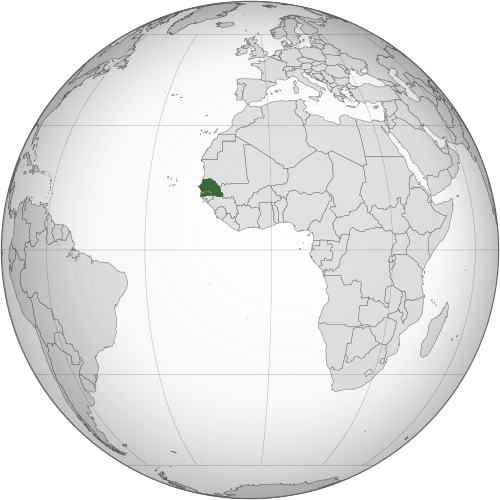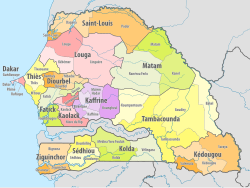Senegal
The Republic of Senegal (French République da Sénégal) is a country in West Africa. The capital is Dakar. Senegal covers a land area of almost 197,000 square kilometres. It has population of about 18 million. The climate is tropical with two seasons: the dry season and the rainy cold season. Senegal was given independence by France in 1960.
Republic of Senegal République du Sénégal (French) | |
|---|---|
| Motto: | |
| Anthem: | |
 Location of Senegal (dark green) | |
| Capital and largest city | Dakar 14°40′N 17°25′W / 14.667°N 17.417°W |
| Official languages | French[1] |
| Ethnic groups (2019)[4] | |
| Religion (2019)[4] |
|
| Demonym(s) | Senegalese |
| Government | Unitary presidential republic[5] |
| Bassirou Diomaye Faye | |
| Ousmane Sonko | |
| Amadou Mame Diop | |
| Legislature | National Assembly |
| Independence | |
• Republic established | 25 November 1957 |
• from France[c] | 4 April 1960 |
• Withdrawal from the Mali Federation | 20 August 1960 |
• from France[d] | 20 June 1960 |
• as Senegal | 22 September 1960 |
• dissolution of the Senegambia Confederation | 30 September 1989 |
| Area | |
• Total | 196,722[4] km2 (75,955 sq mi) (86th) |
• Water (%) | 2.1 |
| Population | |
• 2024 estimate | 18,847,519[4] (67th) |
| GDP (PPP) | 2023 estimate |
• Total | |
• Per capita | |
| GDP (nominal) | 2023 estimate |
• Total | |
• Per capita | |
| Gini (2011) | 40.3[7] medium |
| HDI (2022) | low · 169th |
| Currency | West African CFA franc (XOF) |
| Time zone | UTC (GMT) |
| Date format | dd/mm/yyyy |
| Driving side | right |
| Calling code | +221 |
| ISO 3166 code | SN |
| Internet TLD | .sn |
Major industries are fish processing, phosphate mining, fertilizer production, petroleum refining, construction materials, ship construction and repair. Peanuts, sugarcane, cotton, green beans, industrial tomato, cherry tomato, melon, and mango are important cash crops.
French is the official language. Since April 2012, Senegal's president has been Macky Sall.
History
In the 15th century, Portuguese people came to Gorée Island off the coast of Dakar. In the 17th century, French people and Dutch people came there, too. These European countries used the island as a trading post in slaves from the mainland, and was controlled by the Muslim Wolof Empires. Slavery was later made illegal by France, but soon after, around 1850, the French started to conquer the Wolof. By 1902 Senegal was a part of the French colony French West Africa.
In January 1959, Senegal and the French Sudan became one to form the Mali Federation, which became fully independent on June 20, 1960, as a result of the independence and transfer of power agreement signed with France on April 4, 1960. This did not last long and Senegal and Mali broke apart into separate nations. Between 1982 and 1989, Senegal and The Gambia joined together to make Senegambia.
On July 1, 2025, France handed over the Rufisque joint station to Senegal. This station, active since 1960, was responsible for communications on the southern Atlantic coast. It also served as a listening station in the fight against maritime trafficking. The handover was carried out without ceremony, limited to the signing of a report. The handover of the last remaining military infrastructure in Senegal to the Senegalese authorities is planned. On July 18, 2025, the two military sites will be returned to the Senegalese government: the airport base and Camp Geille, a 5-hectare site located in Ouakam. Four villas located in Plateau, near the port, will also be transferred to the Senegalese authorities.[9]
Geography
In the north of Senegal is the Senegal River. To the north of the river is Mauritania. The nation borders Mali in the east, Guinea-Bissau in the south, and Guinea in the south-east. The Gambia is another country inside of Senegal, along the Gambia River. It is about 300 km long.
The north of Senegal is part of the Sahel. The highest mountain is 581 m high. The rainy season is between June and October. The average temperature on the coast is about 24° C, and inland about 27° C.
Regions
Senegal Media
National Anthem of Senegal
The Portuguese Empire was the first European power to colonize Senegal, beginning with the arrival of Dinis Dias in 1444 at Gorée Island and ending in 1888, when the Portuguese gave Ziguinchor to the French.
The short-lived Mali Federation
Macky Sall, President of Senegal (2012–2024)
Abdoulaye Wade, President of Senegal (2000–2012)
Land mines were widely used in the Casamance conflict between separatist rebels and the central government.
Notes
- ↑ Article 1 of the 2001 constitution of Senegal. This article says that the national languages are Diola, Malinké, Pular, Sérère, Soninké and Wolof.[2]
- ↑ Arabic is taught as a second language for religion.[3]
- ↑ With French Sudan, as the Mali Federation.
- ↑ As the Sudanese Republic, with Senegal as the Mali Federation.
References
- ↑ "Senegal". The World Factbook. Central Intelligence Agency. 2022-08-23. Archived from the original on 4 February 2021. Retrieved 2024-01-23.
- ↑ "Senegal's Constitution of 2001 with Amendments through 2016" (PDF). Constitute Project. Archived (PDF) from the original on 10 April 2023. Retrieved 20 March 2023.
- ↑ Falola, Toyin (2017-11-30). Africanizing Knowledge: African Studies Across the Disciplines. Routledge. p. 190. ISBN 978-1-351-32438-0.
- ↑ 4.0 4.1 4.2 4.3 "Senegal". The World Factbook. Central Intelligence Agency. 2022-08-23. Archived from the original on 4 February 2021. Retrieved 2024-01-23.
- ↑ "Senegal". The World Factbook. Central Intelligence Agency. 2009. Archived from the original on 4 February 2021. Retrieved 12 October 2015.
- ↑ 6.0 6.1 6.2 6.3 "World Economic Outlook Database, October 2023 Edition. (Senegal)". International Monetary Fund. 10 October 2023. Retrieved 15 October 2023.
- ↑ "Gini Index". World Bank. Archived from the original on 25 December 2018. Retrieved 2 March 2011.
- ↑ "Human Development Report 2023/2024" (PDF). United Nations Development Programme. 13 March 2024. Archived (PDF) from the original on 13 March 2024. Retrieved 13 March 2024.
- ↑ Sénégal: la France rétrocède la base de Rufisque, la quatrième remise aux autorités du pays (in French)
| Wikimedia Commons has media related to Lua error in Module:Commons_link at line 62: attempt to index field 'wikibase' (a nil value).. |








